Culture shapes how people live, think, and interact. It is a powerful force that influences societies worldwide. In the Philippines, American culture has left a lasting mark, blending with local traditions to create a unique dynamic.
Historically, the study of American culture has shown its global reach. From language to education, its influence has been significant. In the Philippines, this impact is evident in various aspects of daily life.
Cultural exchange has played a key role in shaping modern Filipino society. American values, behaviors, and societal norms have been adopted by many. This adaptation is seen in both individuals and groups, creating a blend of traditions.
This article explores how American culture has influenced Filipino society. It aims to provide insights into the social dynamics shaped by this cultural exchange. By understanding this impact, we can better appreciate the evolving relationship between the two cultures.
Key Takeaways
- Culture is a powerful force that shapes societies.
- American culture has a significant global influence.
- The Philippines has adapted many American values and norms.
- Cultural exchange plays a key role in modern Filipino society.
- Understanding this impact helps appreciate social dynamics.
Historical Overview of American Influence in the Philippines
American influence in the Philippines dates back to the colonial era, leaving a lasting legacy. This impact began with the Spanish-American War in 1898, which marked the start of a new chapter in Filipino history. The Treaty of Paris transferred sovereignty from Spain to the U.S., setting the stage for decades of cultural exchange.
Pre-colonial and Colonial Beginnings
Before American colonization, the Philippines had its own rich traditions and societal norms. The arrival of the U.S. brought significant changes. Educational reforms introduced English as a primary language, transforming communication and learning. This shift became a key part of the country’s development.
Public celebrations and societal structures also evolved. American holidays like Independence Day were adopted, blending with local traditions. This fusion created a unique cultural identity that continues to thrive today.
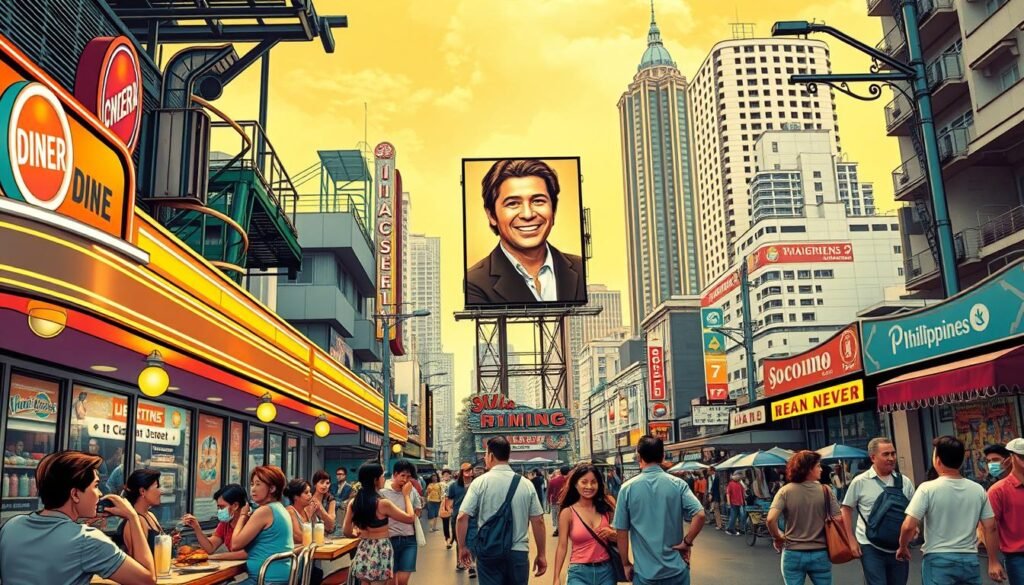
Key Milestones in Cultural Exchange
One of the most notable milestones was the introduction of American media. Hollywood films and television shows became popular, influencing Filipino entertainment. This shift also impacted local traditions, as new forms of storytelling emerged.
Food trends also saw a transformation. American fast-food chains became widespread, introducing burgers and fries alongside traditional Filipino dishes. This culinary blend highlights the adaptability of Filipino food culture.
Education remained a cornerstone of American influence. The establishment of public schools and universities helped spread English as a second language. This bilingual dynamic continues to shape communication in the Philippines.
Defining Culture: Concepts and Perspectives
Understanding culture requires exploring its many layers and definitions. Anthropologists have long debated its meaning, offering frameworks that highlight its complexity. From shared values to societal norms, culture shapes how people interact and perceive the world.
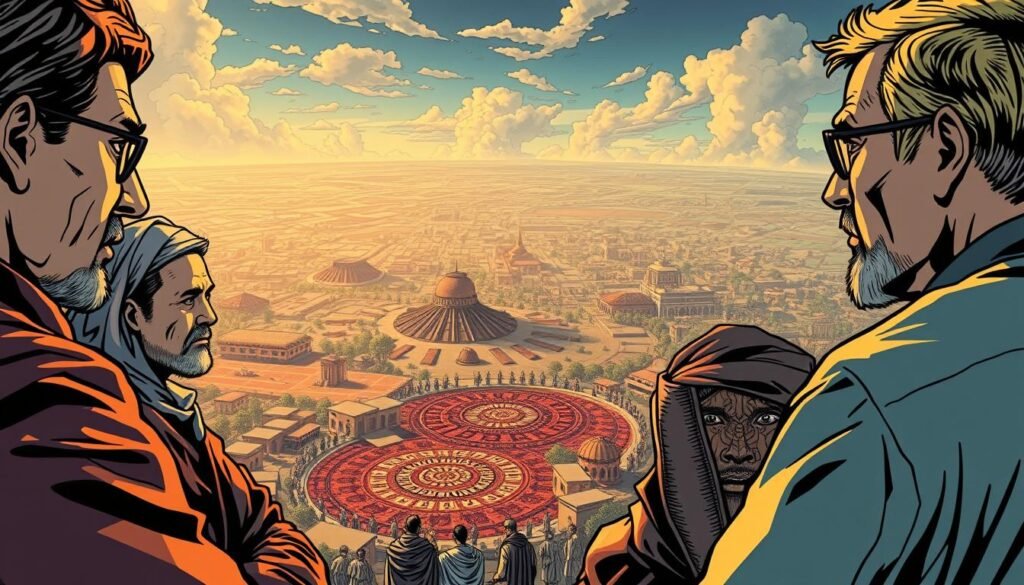
Anthropological Perspectives on Culture
One of the earliest definitions comes from E.B. Tylor, who described culture as “that complex whole which includes knowledge, belief, art, law, morals, custom, and any other capabilities acquired by man as a member of society.” This broad view emphasizes its all-encompassing nature.
Modern anthropologists, like Bronislaw Malinowski, have built on this foundation. Malinowski’s participant-observation method involved living among the people studied, providing deeper insights into their way of life. This approach highlights the importance of firsthand knowledge in understanding cultural dynamics.
Cultural Universals in Society
Cultural universals are elements found in every society, such as art, religion, and social rituals. These shared traits reveal common human experiences while allowing for unique expressions. For example, art serves as a universal medium for storytelling, yet its forms vary widely across the world.
Organizations like UNESCO play a vital role in preserving these universal elements. By safeguarding cultural heritage, they ensure that future generations can learn from and appreciate diverse traditions. This effort highlights the importance of global collaboration in cultural preservation.
In modern society, the study of culture continues to evolve. From examining social rituals to analyzing media influences, it provides valuable insights into human behavior. These practical examples demonstrate how academic theories apply to everyday life.
The American Cultural Footprint in Media and Entertainment
The global reach of American media has reshaped entertainment worldwide. From Hollywood blockbusters to streaming platforms, its influence is undeniable. In the Philippines, this impact has blended with local traditions, creating a unique pop culture landscape.
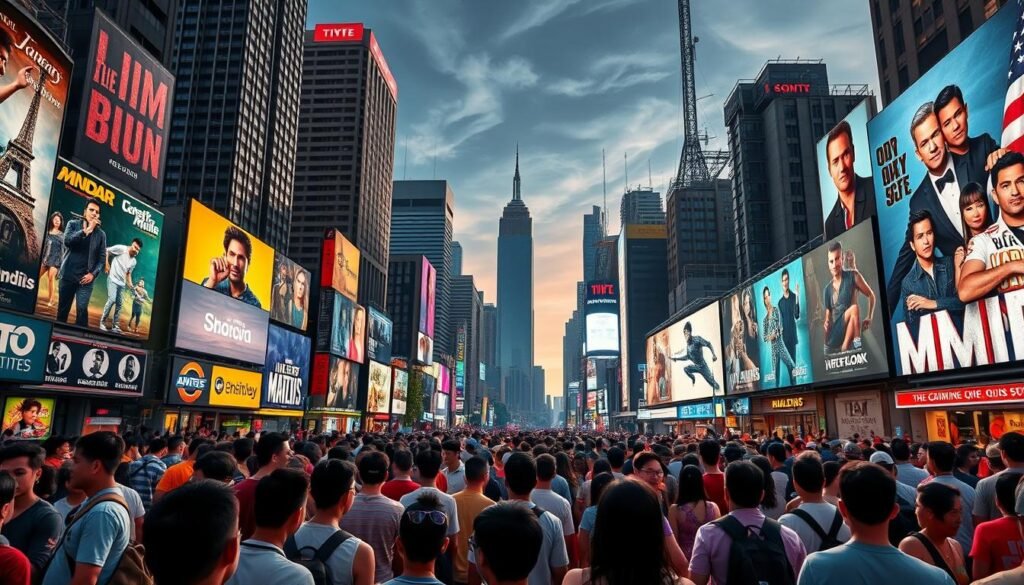
Hollywood’s Role and Local Adaptations
Hollywood has long been a dominant force in global entertainment. Its films and TV shows have shaped storytelling and artistic expression. In the Philippines, this influence is evident in the popularity of American movies and the rise of local adaptations.
For example, Filipino remakes of iconic American shows like Full House and The Voice have gained massive followings. These adaptations blend American formats with Filipino values, creating a unique viewing experience.
Television, Music, and Digital Platforms
Television remains a powerful medium for cultural exchange. American shows often dominate Filipino TV schedules, influencing local programming. Music is another area where American styles, from pop to hip-hop, have inspired Filipino artists.
Digital platforms have further accelerated this exchange. Streaming services like Netflix and Spotify bring American content to Filipino audiences. At the same time, Filipino creators use these platforms to share their work globally.
| Media Type | American Influence | Filipino Adaptation |
|---|---|---|
| Film | Hollywood blockbusters | Local remakes of popular movies |
| Television | American TV shows | Filipino versions of reality shows |
| Music | Pop and hip-hop trends | Filipino artists blending local and Western styles |
| Digital | Streaming platforms | Filipino creators gaining global audiences |
The fusion of American and Filipino media highlights the adaptability of society. It also shows how digital platforms serve as modern channels for cultural exchange. For more insights into this dynamic, explore this detailed analysis.
Transformation of Filipino Traditions and Customs
The blending of American and Filipino traditions has reshaped daily life in the Philippines. Over time, this cultural exchange has introduced new practices while preserving traditional elements. This transformation is evident in various aspects of Filipino society, from family dynamics to community celebrations.
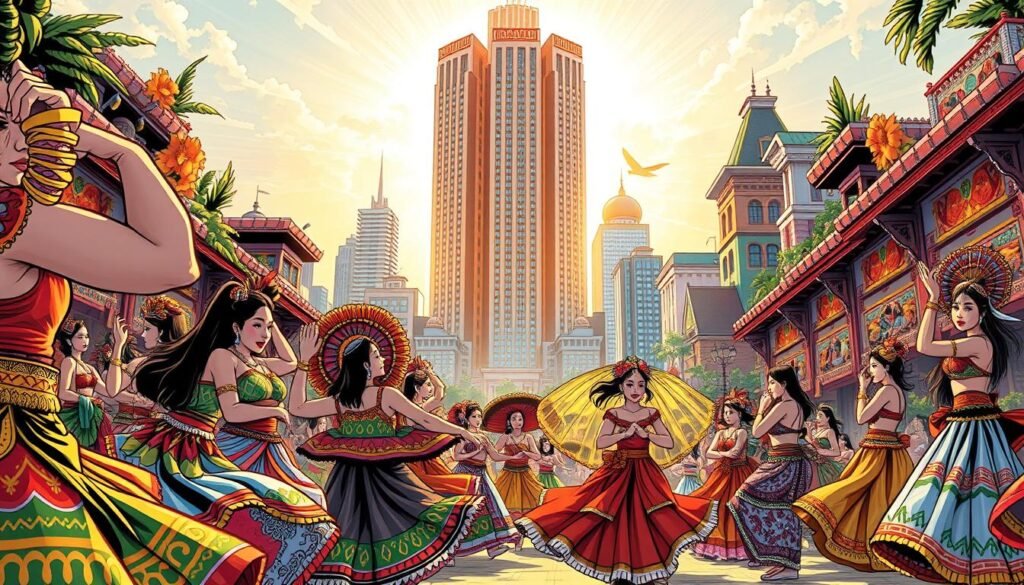
Adoption of New Practices
American influence has significantly altered longstanding Filipino customs. For example, the extended family structure remains central, but modern values like individualism have started to blend with traditional collectivism. This shift is particularly noticeable in urban areas, where Western lifestyles are more prevalent.
Work environments have also evolved. The American emphasis on efficiency and professionalism has influenced Filipino workplaces. Many companies now adopt practices like flexible hours and team-building activities, merging American work ethics with Filipino hospitality.
Community celebrations have adapted as well. Traditional fiestas now often include elements of American pop culture, such as music and fashion. This fusion creates a unique experience that honors both heritage and modernity.
These changes have impacted the overall quality of daily life. While some traditional elements remain, the integration of new practices has brought both challenges and opportunities. Understanding this balance helps appreciate the evolving Filipino identity.
Language and Communication: Bridging Two Worlds
Language serves as a bridge connecting diverse communities and fostering mutual understanding. In the Philippines, the rise of English as a lingua franca has transformed communication, blending with native dialects to create a unique bilingual dynamic. This evolution reflects the adaptability of Filipino society in embracing global influences while preserving local customs.
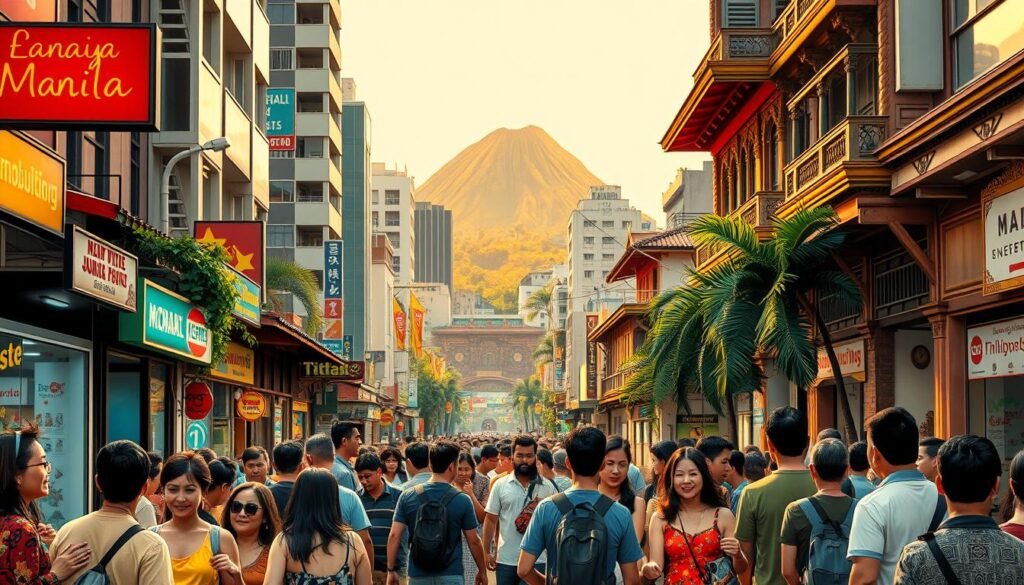
The Rise of English as a Lingua Franca
English has become a vital tool for linking the Philippines with the global community. Introduced during the American colonial era, it has since evolved into a second language for many Filipinos. This shift has reshaped education, media, and professional environments, creating opportunities for international collaboration.
In schools, English is often the medium of instruction, fostering bilingualism from an early age. This dual-language system not only enhances cognitive flexibility but also prepares students for a globalized workforce. The ability to switch between languages is a valuable skill in today’s interconnected state of the world.
Bilingual Dynamics in Daily Life
In everyday interactions, Filipinos seamlessly blend English with native languages like Tagalog and Cebuano. This bilingualism reflects the adaptability of Filipino behavior in diverse settings. For instance, conversations often switch between languages, depending on the context and audience.
Media and entertainment also play a significant role in this dynamic. American TV shows and movies are widely consumed, influencing local content creation. At the same time, Filipino creators use English to reach global audiences, showcasing the country’s rich customs and traditions.
| Aspect | English Influence | Filipino Adaptation |
|---|---|---|
| Education | Medium of instruction | Bilingual curriculum |
| Media | American TV shows | Local content in English |
| Workplace | Professional communication | Code-switching in meetings |
| Social Interactions | English as a second language | Blending with native dialects |
This bilingual dynamic highlights the Philippines’ ability to balance tradition with innovation. By embracing English while preserving native languages, Filipinos create a unique cultural identity that thrives in a globalized environment.
Culinary Fusion: Food as a Cultural Dialogue
The culinary landscape of the Philippines reflects a rich dialogue between local and global influences. Over time, American fast-food trends have merged with traditional Filipino flavors, creating a unique fusion that resonates across the region. This blend highlights the adaptability of Filipino cuisine while preserving its rich heritage.
Fast-Food Trends and Traditional Flavors
American fast-food chains like McDonald’s and KFC have become staples in the Philippines. However, these chains have adapted to local tastes by incorporating Filipino ingredients and dishes. For example, McDonald’s offers Chicken McDo with a side of rice, a nod to Filipino dining habits.
Regional flavors also play a significant role in this culinary dialogue. In the Visayas region, fast-food menus often feature seafood-inspired dishes, while in Luzon, hearty meat-based meals dominate. This localization ensures that fast food feels familiar yet innovative.
Research and Innovation in Culinary Studies
Universities and culinary organizations have studied this fusion extensively. The University of the Philippines, for instance, has conducted research on how fast-food trends influence local eating habits. Their findings reveal that this blend not only shapes modern cuisine but also serves as an activity that connects generations.
- American fast-food chains adapt to Filipino tastes.
- Regional ingredients create unique culinary experiences.
- Universities study the impact of food trends on society.
- Food serves as a bridge between tradition and innovation.
Food is more than sustenance; it’s a cultural dialogue. From family gatherings to street food festivals, it brings people together. This connection fosters a sense of identity while celebrating the Philippines’ evolving culinary landscape.
Modern Filipino cuisine is a testament to this fusion. Dishes like adobo-flavored burgers and lechon pizza showcase how tradition and innovation coexist. These creations reflect the Philippines’ ability to embrace global influences while staying true to its roots.
Education and Cultural Exchange Through Universities and Organizations
Universities play a pivotal role in bridging cultural divides through academic programs. By fostering global understanding, they create opportunities for students and scholars to engage in meaningful communication across borders. This exchange has a rich history, shaping the way societies interact and learn from one another.
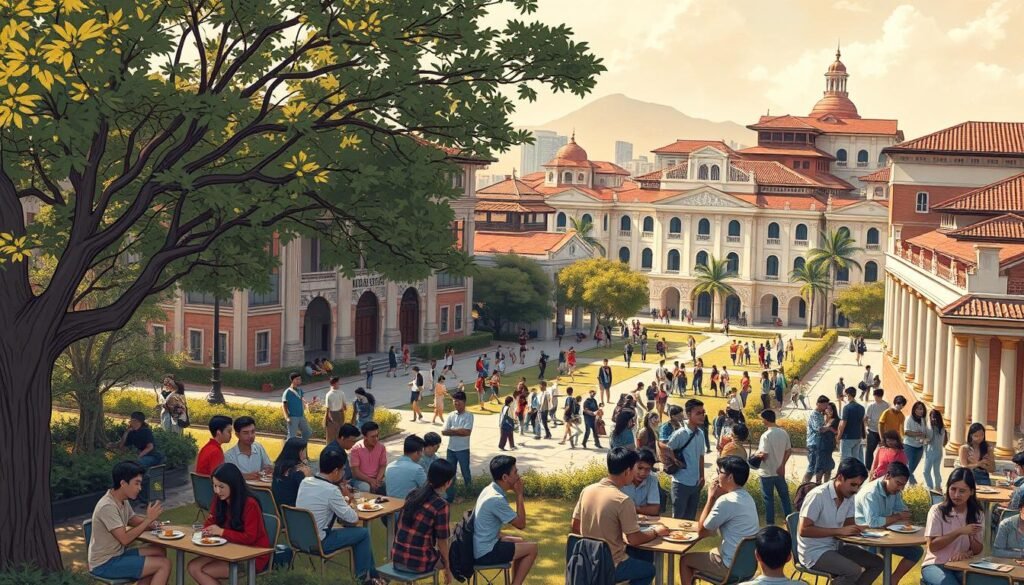
Study Abroad and Exchange Programs
Study abroad programs have become a cornerstone of cultural exchange. These initiatives allow students to immerse themselves in new environments, enhancing their language skills and global perspectives. For example, Filipino students studying in the U.S. often return with a deeper appreciation for American values, while American students in the Philippines gain insights into local traditions.
Research shows that participants in these programs are 30% more likely to develop a global mindset. This exposure not only enriches academic learning but also fosters personal growth. As one student noted, “Living abroad taught me to adapt and appreciate diversity in ways I never imagined.”
Institutional Collaborations in Cultural Studies
Universities and organizations have also partnered to advance cultural research. These collaborations focus on interdisciplinary work, combining fields like anthropology, sociology, and history. For instance, joint projects between the University of the Philippines and American institutions have explored the impact of colonial history on modern Filipino society.
Such efforts enhance communication between scholars, leading to innovative findings. They also prepare students for a globalized workforce by equipping them with cross-cultural competencies. As this study highlights, cultural exchange programs significantly enrich academic and personal experiences.
- Study abroad programs foster cross-cultural understanding.
- Institutional collaborations enhance research and innovation.
- Educational exchanges have a lasting impact on global perspectives.
- Universities play a key role in shaping future cultural studies.
The history of educational exchanges demonstrates their transformative power. By continuing to invest in these programs, universities and organizations ensure that cultural understanding remains a priority in an increasingly interconnected world.
Lifestyle Shifts: Behavior and Social Norms in Transition
The evolution of social norms in the Philippines reflects a dynamic interplay between tradition and modernity. As American influences blend with local customs, daily behavior and societal expectations are undergoing significant transformation. This shift is evident in various aspects of life, from family dynamics to community interactions.
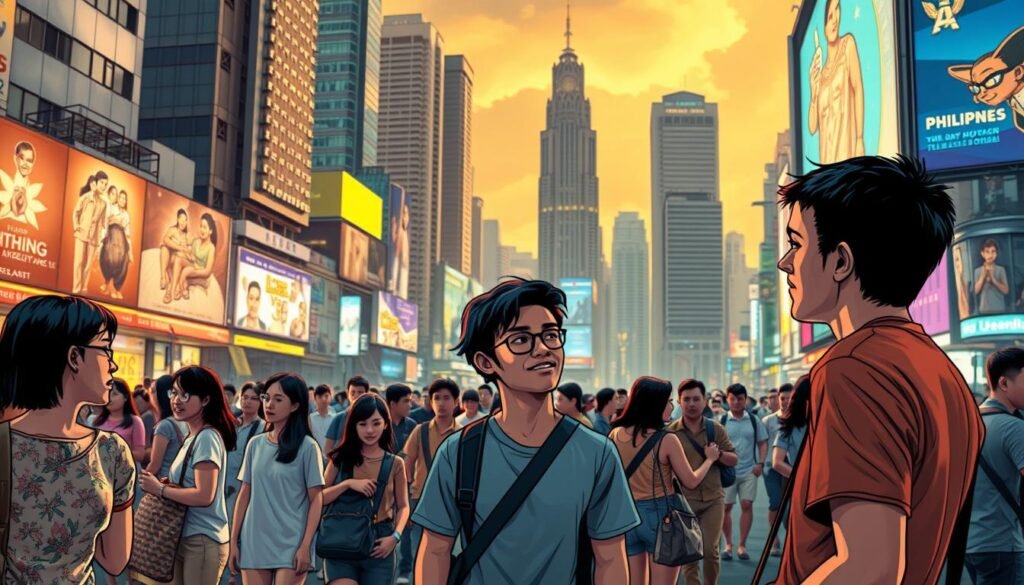
Modern Versus Traditional Values
Traditional Filipino values emphasize close-knit family ties and community harmony. However, modern lifestyles, influenced by global trends, are introducing new perspectives. For instance, individualism is becoming more prevalent, especially in urban areas. This change challenges the collectivist mindset that has long defined Filipino society.
Art and cultural expression have also adapted to these shifts. Traditional forms of art, such as folk dances and indigenous crafts, now coexist with contemporary styles influenced by Western media. This fusion reflects the adaptability of Filipino creativity in a rapidly changing world.
Media and technology play a significant role in reshaping behavior. Social media platforms, for example, have become a powerful system for spreading new ideas and trends. Younger generations are particularly influenced by these digital spaces, which often promote values different from those of their parents.
Negotiating Shifting Values
Families are at the forefront of navigating these changes. While older members may hold onto traditional values, younger ones often embrace modern ideals. This dynamic can lead to generational tensions but also fosters dialogue and mutual understanding.
Community systems also play a crucial role in facilitating or resisting these shifts. In rural areas, traditional norms often remain strong, while urban centers are more open to innovation. This contrast highlights the diverse ways Filipino society adapts to global influences.
- Modern lifestyles challenge traditional family structures.
- Art serves as a bridge between old and new cultural expressions.
- Media and technology drive behavioral change.
- Families negotiate shifting values while maintaining cultural continuity.
- Community systems influence the pace of societal transformation.
Understanding these shifts helps appreciate the evolving Filipino identity. As this research highlights, altering social norms requires strategic efforts to balance tradition with innovation. By fostering dialogue and embracing diversity, Filipino society continues to thrive in a globalized world.
Artistic Expressions: Music, Art, and the Symbolism of Change
Music and art have become powerful tools for symbolizing change and unity in the Philippines. These creative forms reflect the blending of American and Filipino ideas, creating a vibrant cultural tapestry. From traditional motifs to contemporary designs, artistic expressions serve as a bridge between cultures, fostering understanding and shared experiences.
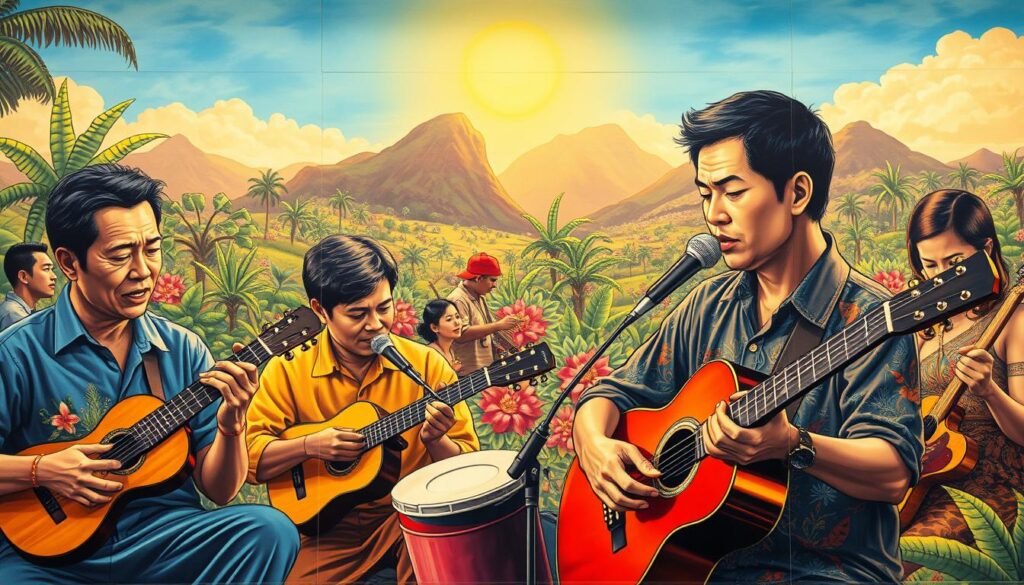
Impact on Local Arts and Creative Practices
American artistic ideas have deeply influenced Filipino creative practices. For example, modern Filipino painters often blend traditional themes with Western techniques. This fusion is evident in works that incorporate indigenous symbols alongside abstract styles, showcasing the adaptability of local artists.
Music has also seen significant transformation. Filipino musicians now blend traditional instruments with American genres like jazz and hip-hop. This habit of innovation has created a unique sound that resonates both locally and globally. As this study highlights, such artistic practices celebrate diversity and foster social cohesion.
Cultural Celebrations and Festivals
Festivals in the Philippines are a vivid display of cultural exchange. Many celebrations now feature elements of American pop culture, such as music and fashion, alongside traditional dances and rituals. For instance, the Sinulog Festival in Cebu incorporates modern performances while honoring its religious roots.
These events serve as a platform for united communities to express their shared heritage. They also highlight the evolving role of art in connecting people across generations. As this analysis notes, art continues to be a vital tool for reshaping perceptions and fostering empathy.
- American artistic ideas merge with traditional Filipino motifs.
- Music and art symbolize cultural change and unity.
- Festivals blend religious and secular elements.
- Creative habits evolve, reflecting global influences.
- Art unites communities through shared expressions.
Societal and Ideological Shifts: The Dynamics of Change
Societal and ideological shifts often reflect deeper transformations in values and norms. In the Philippines, the long-term influence of American culture has played a significant role in reshaping societal structures. These changes are not just superficial but involve a recalibration of ideas and principles to align with evolving norms.
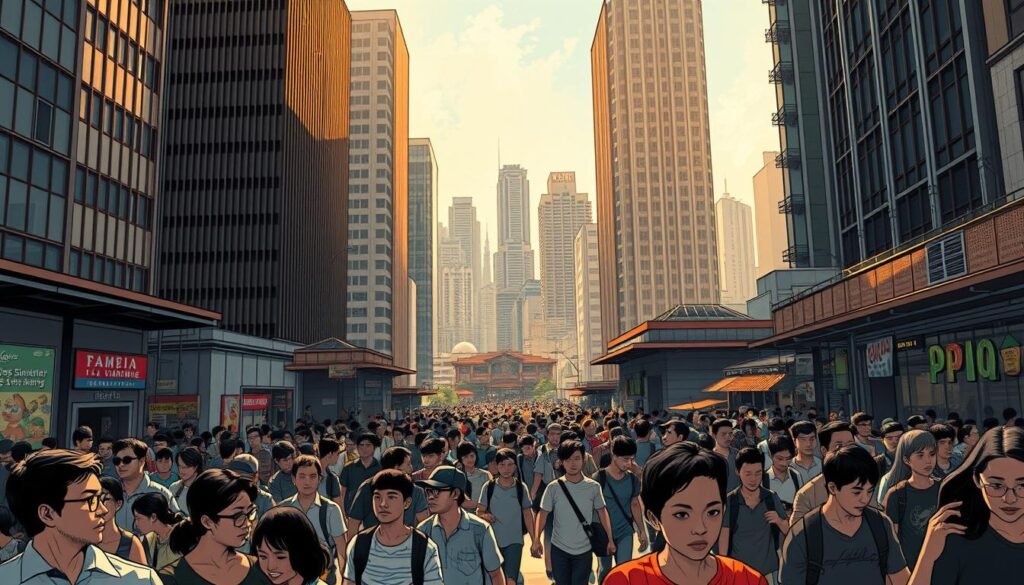
One key aspect of this transformation is the shift from traditional forms to new cultural models. As development progresses, older practices often give way to modern approaches. For example, the emphasis on individualism in American culture has started to blend with the collectivist mindset traditionally dominant in Filipino society.
Rights and responsibilities within modern culture have also evolved. The concept of individual rights, influenced by American ideals, has gained prominence. This shift is evident in areas like gender equality and freedom of expression, where Filipino society has adopted more progressive stances.
Historical examples illustrate this dynamic process of cultural repositioning. The civil rights movement in the United States, for instance, inspired similar efforts in the Philippines, leading to changes in laws and social attitudes. Such movements highlight how external influences can drive internal development.
The recalibration of ideas is another critical aspect of societal change. Filipino values, while rooted in tradition, have adapted to incorporate global perspectives. This adaptability ensures that society remains relevant in a rapidly changing world.
Understanding these shifts requires examining the interplay of ideology and societal evolution. As this analysis shows, social change is a complex process influenced by multiple factors. By studying these dynamics, we can better appreciate the evolving relationship between cultures.
- Traditional forms evolve with societal development.
- Rights and responsibilities adapt to modern cultural norms.
- Historical examples highlight the process of cultural repositioning.
- Ideas and principles are recalibrated to reflect evolving societal values.
- The interplay of ideology and societal evolution drives long-term change.
These shifts underscore the adaptability of Filipino society. By embracing new ideas while preserving core values, the Philippines continues to thrive in a globalized world.
Community Response and Adaptation: Preserving Heritage Amid Modernization
Communities worldwide face the challenge of preserving their heritage while embracing modernization. In the Philippines, this balance is particularly delicate as American influences continue to shape societal norms. Filipino communities are finding innovative ways to maintain their identity while adapting to global trends.
Balancing Tradition with Innovation
Anthropologists emphasize the importance of understanding the definition of heritage in a rapidly changing world. For Filipino communities, this means safeguarding traditional practices while integrating new ideas. Community-led initiatives play a crucial role in this process, ensuring that cultural identity remains intact.
One example is the preservation of indigenous crafts. Local organizations work to teach younger generations traditional skills, blending them with modern designs. This approach not only keeps the different culture alive but also makes it relevant in today’s context.
Educational programs are another key strategy. Schools and universities collaborate with anthropologists to create curricula that highlight Filipino heritage. These programs foster a deeper appreciation for local traditions while encouraging innovation.
The tension between preserving heritage and embracing change is evident in many aspects of Filipino life. Festivals, for instance, now incorporate elements of American pop culture while maintaining their traditional roots. This fusion reflects the adaptability of Filipino society.
Case studies show that successful cultural adaptation requires a collaborative effort. Communities, organizations, and scholars must work together to find a balance. As highlighted in this research, community participation is essential for sustainable heritage conservation.
- Community-led initiatives preserve traditional practices.
- Educational programs integrate heritage with modern learning.
- Festivals blend traditional and contemporary elements.
- Collaboration ensures successful cultural adaptation.
- Anthropologists provide valuable insights into heritage preservation.
By balancing tradition with innovation, Filipino communities are creating a dynamic cultural landscape. This approach ensures that their heritage remains vibrant and relevant for future generations.
Conclusion: Reflecting on a Shared Future
The interplay between American and Filipino traditions has created a dynamic societal evolution. Over time, the exchange of values and practices has reshaped the Filipino lifestyle, blending local customs with global influences. Language, media, and education have been pivotal in this transformation, fostering a bilingual and culturally rich environment.
This mutual exchange has not only enriched Filipino society but also strengthened ties between the two nations. From group person interactions to community celebrations, the blending of traditions highlights the adaptability of Filipino culture. As this study shows, such cultural dialogues are essential for fostering mutual respect and understanding.
Looking ahead, the shared future of these intertwined cultures holds promise. By continuing to embrace diversity and innovation, both nations can build a more inclusive and harmonious lifestyle. This ongoing dialogue underscores the importance of preserving heritage while adapting to modern trends.
In conclusion, the transformative impact of American culture on Filipino society is a testament to the power of cultural exchange. By valuing each word and tradition, we can ensure a future where diverse group persons thrive together in mutual respect and understanding.
FAQ
How has American culture influenced Filipino society?
American culture has shaped Filipino society through media, education, language, and lifestyle. This influence is seen in the adoption of English, fast-food trends, and modern social norms.
What are some key milestones in the cultural exchange between the U.S. and the Philippines?
Key milestones include the American colonial period, the introduction of English, and the rise of Hollywood and fast-food chains in the Philippines.
How do anthropologists define culture?
Anthropologists view culture as a system of shared beliefs, values, and practices that shape a group’s way of life and identity.
What role does Hollywood play in Filipino entertainment?
Hollywood has influenced local media by inspiring adaptations of American films and TV shows, blending global and Filipino storytelling styles.
How has Filipino cuisine evolved with American influence?
Filipino cuisine has embraced fast-food trends while maintaining traditional flavors, creating a unique fusion of both culinary worlds.
What is the significance of English in the Philippines?
English serves as a lingua franca, bridging communication in education, business, and daily life, making the Philippines a bilingual society.
How do universities contribute to cultural exchange?
Universities foster exchange through study abroad programs and collaborations, promoting cross-cultural understanding and knowledge sharing.
How are traditional Filipino values adapting to modern influences?
Traditional values are evolving to balance modern lifestyles, blending respect for heritage with contemporary social norms.
What impact has American culture had on Filipino art and music?
American culture has inspired local artists and musicians, leading to innovative styles while preserving traditional artistic expressions.
How do Filipino communities preserve their heritage amid modernization?
Communities preserve heritage by integrating traditional practices with modern innovations, ensuring cultural continuity in a changing world.
Source Links
- Philippines – US Influence, Colonialism, Revolution | Britannica
- During Filipino American History Month, Reflecting on What a Cultural Center Can Mean to a Community | Local Initiatives Support Corporation
- Americans in the Philippines
- U.S. Relations With the Philippines – United States Department of State
- Philippine-American War | Facts, History, & Significance | Britannica
- The Culture Concept
- Culture
- Current Trends in Media and Entertainment Industry – Miquido Blog
- Mindset Matters: The Influence of Entertainment And The Significance Of Culture Change In The Business Of A New Decade
- Philippines – Culture, Diversity, Traditions | Britannica
- Culture of the Philippines
- From Tradition to Identity: Exploring the Cultural Heritage of the Philippines
- Bridging Culture with Language Beyond Words
- Bridging Worlds: The Transformative Power of Language Learning and Cultural Immersion
- Cultural Fusion in Cuisine: How Global Influences are Shaping Modern Dishes
- A Dialogue on International Cuisine and Culture
- The intersection of culture and cuisine: How food shapes our identity – Faculty of Arts
- The Importance of Cultural Exchange in Global Education
- The Role of Cultural Exchange Programs in Globalizing Education –
- Barriers to Lifestyle Behavioral Change in Migrant South Asian Populations
- How Do Social and Behavioral Change Interventions Respond to Social Norms to Improve Women’s Diets in Low- and Middle-Income Countries? A Scoping Review
- The Power of Art: Does Art Really Change the World We Live In? – Art Business News
- Symbolism – The Metropolitan Museum of Art
- The Dynamics of Social Change: An Overview • Sociology Notes by Sociology.Institute
- Cultural Shifts: Exploring the Dynamics of Culture
- Community Participation in the Importance of Living Heritage Conservation and Its Relationships with the Community-Based Education Model towards Creating a Sustainable Community in Melaka UNESCO World Heritage Site
- Cultural Influence of Local Food Heritage on Sustainable Development
- Importance of Incorporating Local Culture into Community Development
- EssayGenius AI Essay Writer

